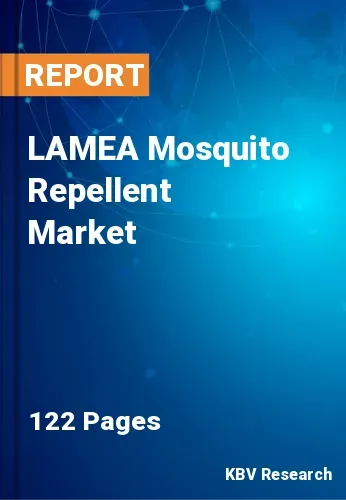The Latin America, Middle East and Africa Mosquito Repellent Market would witness market growth of 7.3% CAGR during the forecast period (2023-2030). In the year 2026, the LAMEA market's volume is expected to surge to 168.1 million units, showcasing a growth of 8.9% (2023-2030).
There's a growing consumer preference for natural and plant-based mosquito repellents. Ingredients like citronella oil, eucalyptus oil, and lemon eucalyptus oil are gaining high demand for their repellent properties, catering to those seeking chemical-free alternatives. Consumers are increasingly seeking mosquito repellents that provide extended protection against bites. Innovations in formulations aim to enhance longevity, ensuring prolonged effectiveness with fewer reapplications. The market is witnessing advancements in delivery mechanisms, including wearable repellent bands, patches, and innovative dispensers. These methods offer convenience, portability, and ease of use, appealing to diverse consumer lifestyles.
Some repellent products leverage technology, such as ultrasonic devices or electronic devices emitting sound waves claimed to repel mosquitoes. The development of clothing and textiles embedded with insect-repellent properties is gaining traction. These fabrics offer an additional layer of protection against mosquito bites. Manufacturers are educating consumers about the proper use of repellents, effective application methods, and the importance of using these products to prevent mosquito-borne illnesses.
Furthermore, the market is extremely competitive, with numerous products designed to satisfy consumers' varied requirements and preferences and many established brands and new entrants. Competition involves continuous innovation in formulations and delivery methods. Companies invest in research and development to create long-lasting, effective, convenient repellents. Advancements in repellent technologies, such as ultrasonic or electronic, also contribute to competition. Effective marketing strategies are vital in shaping consumer perceptions and driving sales. Companies invest in advertising campaigns, endorsements, and informative content to highlight their product efficacy, safety, and convenience.
Rapid and unplanned urban growth often leads to insufficient or poorly designed drainage systems. Inadequate drainage creates stagnant water pools in which mosquitoes, particularly species like Aedes aegypti (responsible for diseases such as dengue, Zika, and chikungunya), breed. Unplanned urbanization in Argentina results in inadequate waste management practices. Piles of improperly disposed waste, including discarded containers, tires, and other items that collect rainwater, create breeding grounds for mosquitoes. In recent years, unplanned urban expansion in Argentina has reduced green spaces and deforestation, eliminating natural habitats that regulate mosquito populations. Additionally, standing water in deforested areas can become ideal breeding grounds for mosquitoes. Therefore, climate change and unplanned urbanization in the region are propelling the growth of the market.
The Brazil market dominated the LAMEA Mosquito Repellent Market, by Country in 2022, and would continue to be a dominant market till 2030; thereby, achieving a market value of $265.1 Million by 2030. The Argentina market is exhibiting a CAGR of 8% during (2023 - 2030). Additionally, The UAE market would experience a CAGR of 7% during (2023 - 2030).
Free Valuable Insights: The Worldwide Mosquito Repellent Market is Projected to reach USD 9.6 Billion by 2030, at a CAGR of 6.1%
Based on Distribution Channel, the market is segmented into Hypermarkets/Supermarkets, Independent Stores, Online, and Others. Based on Type, the market is segmented into Spray, Vaporizer, Cream & Oil, Coil, Mat, and Others. Based on countries, the market is segmented into Brazil, Argentina, UAE, Saudi Arabia, South Africa, Nigeria, and Rest of LAMEA.

By Distribution Channel (Volume, Million units, USD Billion, 2019-2030)
By Type (Volume, Million units, USD Billion, 2019-2030)
By Country (Volume, Million units, USD Billion, 2019-2030)
Our team of dedicated experts can provide you with attractive expansion opportunities for your business.

